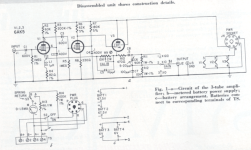Hi,
I have ATTEN ADS 1062CML 60MHz 2-channel digital oscilloscope and it has quite poor input sensitivity. My idea is to build 2-channel low-noise pre-amplifier. I'm mostly need oscilloscope for debugging vacuum tube audio circuits. Occasionally I come across article "Measure Milli-volts with Decade Amp" in Radio Electronics magazine 1960-09, which is designed as add-on for voltmeter or oscilloscope. It has gain of 100, 5Hz - 1MHz bandwidth, 1M input resistance, 1K output impedance, and because of vacuum tubes (3 x 6AK5), immune against input overload. Noise with input shorted is 300uV. Overload input voltage is 0.25V.
Schematic and the whole article in attachment. My idea is to build 2 channels, power it on from separate HV windings of toroidal transformer, and make separate GND for each channel.
Also, I would like to replace 1MOhm grid leak resistor with a series of 3 to make 1/10/100 attenuation of the input signal, so no need for countless switch of the oscilloscope probes between this pre-amplifier and digital oscilloscope.
What is your opinion? Is this a good idea? Any suggestion is greatly appreciated.
Thanks in advance.
I have ATTEN ADS 1062CML 60MHz 2-channel digital oscilloscope and it has quite poor input sensitivity. My idea is to build 2-channel low-noise pre-amplifier. I'm mostly need oscilloscope for debugging vacuum tube audio circuits. Occasionally I come across article "Measure Milli-volts with Decade Amp" in Radio Electronics magazine 1960-09, which is designed as add-on for voltmeter or oscilloscope. It has gain of 100, 5Hz - 1MHz bandwidth, 1M input resistance, 1K output impedance, and because of vacuum tubes (3 x 6AK5), immune against input overload. Noise with input shorted is 300uV. Overload input voltage is 0.25V.
Schematic and the whole article in attachment. My idea is to build 2 channels, power it on from separate HV windings of toroidal transformer, and make separate GND for each channel.
Also, I would like to replace 1MOhm grid leak resistor with a series of 3 to make 1/10/100 attenuation of the input signal, so no need for countless switch of the oscilloscope probes between this pre-amplifier and digital oscilloscope.
What is your opinion? Is this a good idea? Any suggestion is greatly appreciated.
Thanks in advance.
Attachments
Out of curiosity: Why would you use a 60+ year old tube circuit instead of a current SS design? E
1) Its immune to high-voltage input overload (its for debugging vacuum tube circuits).
2) I don't have free SS-based design of similar tool.
2) I don't have free SS-based design of similar tool.
An attenuator at the input is worse for noise than one at the output.
A 1:10 probe is bad for noise, but much reduces probe input capacitance, because the circuit under test doesn't have to drive the probe's cable capacitance, but the series connection of a small capacitor inside the probe and the cable+scope.
A 1:10 probe is bad for noise, but much reduces probe input capacitance, because the circuit under test doesn't have to drive the probe's cable capacitance, but the series connection of a small capacitor inside the probe and the cable+scope.
Have a look here: https://sound-au.com/articles/oscilloscope.htm. Fig. 12 shows a preamp that could be adapted to your needs. E
